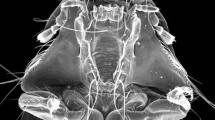Summary
Inspired by the breeding technique ofFinney, Flanders andSmith, the one which we have elaborated can be carried out by a reduced personnel, thanks to an increase of the output.
The adults of theGnorimoschema operculella that are fed lay 300 eggs, most of them within 4 days. The limited keeping of the eggs and adults of the moth is possible at low temperatures and depends on the deficit of saturation of air moisture.
The limited keeping of the cocoons ofM. ancylivorus containing larvae in their last stage can be assured at low temperatures.
The notion of breeding index based on the variations of the rate of multiplication of the parasite for given relative densities makes it possible to check the breeding conditions. The average rate of multiplication which has been obtained is 76.
The breeding technique must allow for the absolute necessity of preventing the extension of possible epidemics this implies a choice of desinfectable materials, the rotation of breeds, the separation of stages, the division of breeds in separable groups, the isolation of soiled implements, the periodical disinfection of the premises and materials.
The technique we make use of enables a single man to obtain an output of 280 000 cocoons ofM. ancylivorus per month.
Resumen
Inspirada en la técnica de cría deFinney, Flanders y Smith, la que hemos elaborado puede ser aplicada por un personal limitado merced a un aumento de los rendimientos.
Los adultos deGnorimoschema operculella alimentados, ponen 300 huevos, la mayor parte en 4 días. La conservación limitada de los huevos y de los adultos es posible con bajas temperaturas y depende del déficit de saturación en vapor de agua.
La conservación limitada de los capullos deM. Ancylivorus que contienen larvas en su último estado se puede obtener conbajas temperaturas.
La noción de índice de cría basada en las variaciones del coeficiente de multiplicación del parasito para densidades relativas dadas permite la verificación de las condiciones de cría. Ha sido de 76 el coeficiente medio de multiplicación.
En la técnica de cría, se debe tomar en consideración la necesidad absoluta de precaver la extensión de eventuales epidemias. Esto supone la elección de materiales desinfectables la permutación de las crías, la separación de los estadios, el fraccionamiento de las crías en grupos, aislables, el aislamiento del material ensuciado, la desinfección periódica de los locales y materiales.
La técnica utilizada permite la producción de 280 000 capullos deM. ancylivorus al mes por solo un individuo.
Similar content being viewed by others
Bibliographie
Allen, H. W. — 1931. The mass production ofMacrocentrus ancylivorus, a parasite of the oriental fruit moth, and its distribution from Southern New Jersey. —J. Ec. Ent.,24, 309–314.
Allen, H. W. &M. H. Brunson. — 1947. Control ofNosema disease of potato tuberworm, a host used in the mass production ofMacrocentrus ancylivorus. —Science,105, 394–395.
Bartlett, K. A. — 1938. The introduction and colonisation in Puerto Rico ofMacrocentrus ancylivorus. — P. R. Agric. Sta. Not, no 80.
Bartlett, B. R. — 1953. A tactile ovipositional stimulus to cultureM. ancylivorus on an unusual host. —J. Ec. Ent.,46, 525.
Daniel, D. M. — 1930. Utilizing parasites in controlling the Oriental Fruit moth. —Ann. Ent. Soc. Amer.,29.
Daniel, D. M. — 1932.Macrocentrus ancyluvorus Roh. a polyembrionic Braconid parasite of the oriental Fruit moth. —Tech. Bull. N. Y. Agric. Exp. Sta., no 187, 79–100.
Fink, D. E. — 1926. The biology ofMacrocentrus ancylivorus Roh. an important parasite ofAncylis comtpana Fr. —J. Agric. Res.,33, 993–1007.
Finney, G. L., S. E. Flanders &H. S. Smith. — 1947. Mass culture ofMacrocentrus ancylivorus and its host, the potato tuber moth. —Hilgardia 17, no 13, 437–483.
Finney, G.L., C.H. Martin &S.E. Flanders. — 1945. Influence of moisture on the mass propagation ofMacrocentrus ancylivorus. —J. Ec. Ent.,38, 319–323.
Flanders, S.E. — 1943. The potato tuber worm a suitable host for mass production ofMacrocentrus ancylivorus. —J. Ec. Ent.,36, 807.
Flanders, S.E. — 1944. Olfactory responses of parasiticHymenoptera in relation to their mass production. —J. Ec. Ent.,37, 711–712.
Flanders, S.E. — 1945. The role of the spermatophore in the mass propagation ofMacrocentrus ancylivorus. —J. Ec. Ent.,38, 323–327.
Flanders, S.E. — 1954. Fecundity of entomophagous insects under mass cultures, an effect of environmental resistance. —Ecology,35, 245–249.
Gontarski, von H. — 1954. Uber die Wirkungsweise von «Nosemack». —Deutsche Bienenwirtschaft,9, 185–188.
Koizumi, K. — 1955. Effects of constant temperature upon the development of the potato tubermoth,Gnorimoschema operculella. —Sci. Rep. Fac. Agr. Okayama,7, 36–45.
Labeyrie, V. — 1957. Influence de l'alimentation sur la ponte deGnorimoschema operculella. — Bull. Soc. Ent. Fr. (sous presse).
Martin, C.H. — 1946. Influence of characteristics of the puncture in potatoes on parasitism of potato tuber moth byMacrocentrus ancylivorus. —J. Ec. Ent.,39, 516–520.
Martin, C.H. &G.L. Finney. — 1946. Control of the sex-ratio inMacrocentrus ancylivorus. —J. Ec. Ent.,39, 296–299.
Pastrana, D. A. & H. Gahan. — 1947. Elevage de masse deMacrocentrus ancylivorus Roh., parasite naturel du ver du Pêcher dans la République Argentine. —I er Congr. Tech. Ent. Tucuman.
Picard, F. — 1913. La Teigne des Pommes de terre (P operculella Zell.). —Ann. Epiph.,1, 106–176.
Pielou, D.P. &R.F. Glasser. — 1954. Thermal tolerance inMacrocentrus ancylivorus Roh. —Canad. Journ. Zool.,32, 30–38.
Steenburgh, W.E. van. — 1930. A season's work of the colonization in Ontario ofMacrocentrus ancylivorus Roh., a parasite of Oriental peach moth (Laspeyresia molesta Busck.). —Canad. Ent.,62: 71–75.
Steinhaus, E.A. — 1949. Principles of insect pathology. —Mc Graw Hill Book Co, New York, pp. 296 et 598.
Ullyett, G.L. — 1936. The physical ecology ofMicroplectron fuscipennis Zell. —Bull. Ent. Res.,27, 195–217.
Author information
Authors and Affiliations
Rights and permissions
About this article
Cite this article
Labeyrie, V. Remarques sur la mise au point d'un élevage semi-industriel deMacrocentrus ancylivorus Roh . Entomophaga 2, 271–281 (1957). https://doi.org/10.1007/BF02373598
Published:
Issue Date:
DOI: https://doi.org/10.1007/BF02373598




